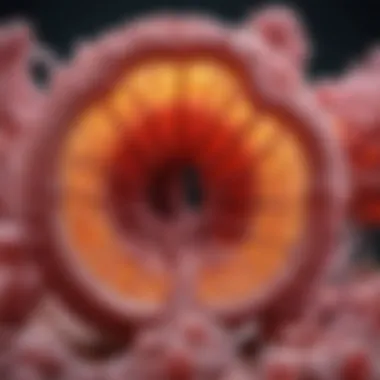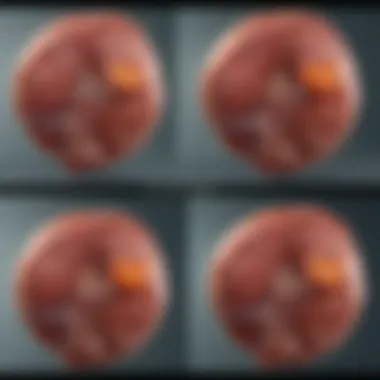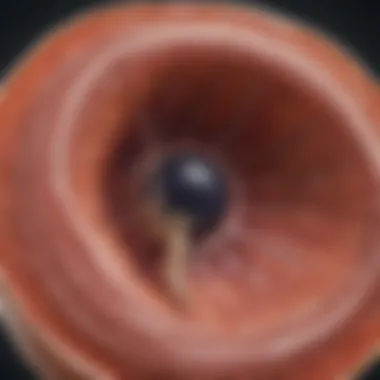Understanding GFR and Kidney Failure Stages


Intro
The understanding of Glomerular Filtration Rate (GFR) and the stages of kidney failure is pivotal in medical practice. GFR serves as a critical indicator of kidney health, guiding clinicians in diagnosing and managing renal disease. Patients and healthcare professionals alike must recognize the implications of declining GFR values. This understanding can lead to better treatment strategies and interventions, ultimately enhancing patient outcomes.
Research Overview
Summary of Key Findings
Research has established that GFR is a valuable metric in assessing kidney function. The normal GFR ranges from 90 to 120 mL/min/1.73 m². Distinct stages of kidney failure can be identified based on GFR values. Each stage is associated with varying degrees of kidney impairment:
- Stage 1: GFR ≥ 90 mL/min – Normal or high GFR with other signs of kidney damage.
- Stage 2: GFR 60-89 mL/min – Mild reduction in GFR.
- Stage 3: GFR 30-59 mL/min – Moderate reduction in GFR.
- Stage 4: GFR 15-29 mL/min – Severe reduction.
- Stage 5: GFR 15 mL/min – Kidney failure.
In clinical practice, assessing GFR helps in determining the best management options for patients, including medication adjustments and the need for dialysis.
Relevance to Current Scientific Discussions
Collectively, studies show the importance of early detection of impaired kidney function. Understanding GFR's role has significant implications not just in nephrology but also in related fields, such as cardiology and endocrinology. The ongoing discussions in scientific circles emphasize improving methods to estimate GFR accurately, especially in specific populations.
Methodology
Research Design and Approach
Most studies focusing on GFR utilize observational designs, examining patient datasets to identify trends over time. Cross-sectional studies often provide snapshots of kidney function at a given moment, while longitudinal studies track changes in GFR and its impact on overall health.
Data Collection and Analysis Techniques
Data collected typically includes serum creatinine levels, demographic information, and comorbidity status. GFR estimation is frequently performed using equations like the Modification of Diet in Renal Disease (MDRD) equation or the Chronic Kidney Disease Epidemiology Collaboration (CKD-EPI) equation. Analysis involves statistical methods to evaluate relationships between GFR values and clinical outcomes, emphasizing the importance of accurate assessments.
"Regular monitoring of GFR is essential for early intervention in kidney illness, significantly improving patient prognosis."
Recognizing these findings facilitates a better understanding of kidney health and the necessity for ongoing education in renal care.
Prologue to Glomerular Filtration Rate
The glomerular filtration rate (GFR) is a crucial indicator of kidney function and overall health. Understanding GFR is essential, as it helps in the assessment of renal health and guides clinical decision-making. Monitoring GFR assists in the early detection of kidney disease, allowing for timely intervention to prevent further damage. The relationship between GFR and kidney function underscores its importance in medical evaluations and patient management. Here, we will discuss its definition, importance, and the mechanisms through which filtration occurs in the kidneys.
Definition and Importance
GFR is defined as the volume of plasma that is filtered through the glomeruli in the kidneys per minute. This measurement is critical for gauging how well the kidneys are functioning. A normal GFR is typically around 90 to 120 milliliters per minute, though this can vary based on factors such as age, sex, and body size.
The importance of monitoring GFR cannot be overstated. It plays a vital role in diagnosing and staging chronic kidney disease (CKD). Early identification of reduced GFR facilitates prompt treatment, which may slow disease progression. Furthermore, evaluating GFR helps to determine appropriate dosing for medications that are eliminated through the kidneys. Misjudgment in GFR may result in adverse drug reactions or treatment failures.
Mechanism of Filtration in the Kidneys
Filtration in the kidneys occurs primarily in the glomeruli, which are tiny capillary networks found in nephrons, the functional units of the kidneys. Blood enters the kidneys via the renal arteries, which further branch into afferent arterioles and ultimately into glomeruli. Here, blood pressure forces water, electrolytes, and waste products through the glomerular filtration membrane.
The filtration mechanism depends on both hydrostatic and oncotic pressures, ensuring that essential components such as proteins and blood cells remain in circulation while allowing waste and excess substances to be filtered out. This process is vital for maintaining homeostasis in the body.
In summary, GFR is a key measure of kidney performance, serving as a reliable indicator of renal health. Understanding the mechanisms that govern glomerular filtration is crucial for health professionals and researchers alike.
Understanding Kidney Function
Understanding the function of the kidneys is crucial in comprehending the overall picture of kidney health. The kidneys serve several fundamental roles that contribute to the body's homeostasis. Each aspect of kidney function interconnects with the concept of Glomerular Filtration Rate (GFR) and offers insights into the stages of kidney failure.


The kidneys are responsible for filtering blood, removing waste products, and regulating electrolyte levels. They also help control blood pressure and balance fluid levels. Therefore, understanding these functions is key for students, researchers, educators, and professionals in the field.
Anatomy of the Kidney
The kidneys are two bean-shaped organs located on either side of the spine, just below the rib cage. Each kidney contains approximately one million nephrons, which are the functional units responsible for filtering blood and producing urine. The structure of the kidney is divided into several key regions:
- Cortex: The outer layer containing renal corpuscles and tubules.
- Medulla: Inner section where urine concentration takes place.
- Pelvis: Funnel-shaped space that collects urine before it flows into the ureter.
The nephron consists of a glomerulus and a series of tubules. The glomerulus filters blood, while the tubules reabsorb substances the body needs. This anatomical arrangement is vital for achieving efficient filtration and excretion of waste.
Physiology of Filtration
The process of filtration in the kidneys involves several stages that work in concert to maintain fluid and electrolyte balance. The primary physiological process begins at the glomerulus, where blood pressure drives plasma into the Bowman’s capsule. Here are key points to understand about this process:
- Filtration: Water and small solutes are filtered out of the blood, forming a pre-urine fluid.
- Reabsorption: As the pre-urine flows through the tubules, water, glucose, and ions are reabsorbed back into the bloodstream.
- Secretion: Additional waste products are secreted into the tubular fluid, which ultimately becomes urine.
This elaborate filtration mechanism highlights the kidneys' ability to regulate substances in the body, making them essential for maintaining health. Understanding kidney function aids in identifying how GFR impacts these processes, particularly in the context of kidney failure.
Stages of Kidney Failure
Understanding the stages of kidney failure is crucial for both patients and healthcare providers. This topic serves as a framework for analyzing kidney health and guides clinical decisions. Each stage implies a different level of damage, which affects treatment options and prognosis. Grasping these stages enables early detection and intervention, greatly influencing patient outcomes. It also fosters a more proactive approach to managing kidney health.
Overview of Staging Systems
The staging of kidney failure is primarily categorized using two models: the National Kidney Foundation's (NKF) stages and the Kidney Disease: Improving Global Outcomes (KDIGO) classification. These systems rely heavily on the measurement of Glomerular Filtration Rate (GFR). The guidelines clearly define five stages, starting from slight damage and escalating to end-stage renal disease. Understanding these staging systems allows both patients and practitioners to track the progression, facilitating timely intervention.
Stage One: Mild Kidney Damage
In stage one, kidney function is still relatively normal, with GFR values greater than 90 mL/min. However, structural abnormalities or risk factors are present. This stage may often go unnoticed due to the absence of clear symptoms. Patients may show minor changes in laboratory tests. Regular monitoring is vital in this phase to prevent progression. Education about blood pressure control and diabetes management can help maintain kidney health.
Stage Two: Moderate Kidney Damage
Stage two is marked by a GFR between 60 and 89 mL/min. Some kidney damage is evident, although issues may still be mild. Patients may experience fatigue and changes in urine output. This stage is about managing underlying conditions and implementing dietary modifications. It is crucial to avoid further stress on the kidneys by avoiding nephrotoxic medications and high-sodium diets.
Stage Three: Severe Kidney Damage
Stage three is split into three parts based on GFR levels: 45-59, 30-44, and 15-29 mL/min. At this level, kidney function is significantly reduced. Symptoms become more apparent, often including generalized swelling, hypertension, and anemia. Lifestyle adjustments and pharmacological management are critical at this phase. If not carefully managed, patients may progress to stage four, necessitating preparation for dialysis or transplantation.
Stage Four: Kidney Failure
In stage four, GFR falls below 15 mL/min, indicating severe kidney dysfunction. Patients will commonly exhibit severe symptoms impacting daily living. Preparing for renal replacement therapy becomes essential. Intervention strategies may include intensive dietary changes, medications to control complications, and establishing a renal replacement plan. Educating patients about dialysis options or transplant eligibility is crucial.
Stage Five: End-Stage Kidney Disease
Stage five, or end-stage kidney disease, marks the final phase of kidney failure, where kidneys can no longer maintain equilibrium. GFR is less than 15 mL/min, leading to the need for dialysis or transplantation for survival. Patients face life-threatening complications without these interventions. Palliative care and discussions regarding advanced directives become necessary topics of conversation at this stage.
The recognition of kidney failure stages is essential in prolonging life and improving quality of life.
Understanding these stages allows for timely action and can significantly alter patient care processes. Each stage has unique treatment paths, underscoring the importance of regular monitoring and intervention.
Clinical Implications of GFR Levels
The Glomerular Filtration Rate (GFR) is a crucial indicator for assessing kidney function. Understanding GFR levels allows healthcare professionals to better manage patients with kidney disease. It is essential for guiding treatment decisions, monitoring disease progression, and evaluating the effectiveness of interventions. Low GFR can signal underlying health issues, making it imperative to have a thorough understanding of its implications.


A proper interpretation of GFR results helps in identifying complications related to kidney function. When GFR levels fall below normal ranges, clarity on how to proceed with patient care becomes critical. This understanding can impact lifestyle adjustments and medical treatments aimed at improving kidney health. More importantly, it fosters the necessity for timely interventions, which can make a significant difference in patient outcomes.
Interpreting GFR Results
GFR results are typically expressed in milliliters per minute and vary based on age, sex, and body size. A figure above 90 mL/min generally indicates normal kidney function. However, when GFR values drop below this level, stages of kidney dysfunction escalate, categorized from mildly impaired to end-stage disease.
Medical professionals often utilize the following thresholds for interpretation:
- Stage 1: GFR 90 mL/min or more (normal kidney function)
- Stage 2: GFR 60-89 mL/min (mild reduction in kidney function)
- Stage 3: GFR 30-59 mL/min (moderate reduction)
- Stage 4: GFR 15-29 mL/min (severe reduction)
- Stage 5: GFR less than 15 mL/min (kidney failure)
It is vital to combine GFR results with other clinical evaluations. Factors such as urine output, symptoms, and imaging studies can provide a more holistic view of kidney health.
Complications Associated with Low GFR
Low GFR levels introduce several potential complications that affect overall health. As kidney function declines, the body’s ability to filter waste diminishes, leading to a buildup of toxins. This situation can manifest in various ways, including:
- Hypertension: Reduced filtration capacity often correlates with increased blood pressure.
- Anemia: The kidneys produce erythropoietin, a hormone that stimulates red blood cell production. Low GFR can reduce its levels, contributing to anemia.
- Bone Disease: Impaired kidney function interferes with calcium and phosphorus management, which can lead to metabolic bone diseases.
- Cardiovascular Issues: There is a strong link between low GFR and cardiovascular diseases, increasing the risk of heart attack or stroke.
“Understanding the implications of GFR levels is crucial in managing kidney diseases effectively.”
Regular monitoring and assessment of GFR play a pivotal role in avoiding these complications. For anyone experiencing symptoms related to kidney dysfunction, prompt medical attention is advised.
Diagnostic Approaches
Diagnostic approaches to assess Glomerular Filtration Rate (GFR) and understand kidney health play a crucial role in early detection and management of kidney disease. Accurate measurement of GFR is necessary for determining the severity of kidney dysfunction, guiding treatment decisions, and improving patient outcomes. Different methodologies exist, each with its specific advantages and considerations. Understanding these approaches is essential for both healthcare providers and patients alike, as they influence the course of treatment and ultimately the quality of life of those affected by kidney conditions.
Tests to Measure GFR
Tests to measure GFR typically involve either direct or indirect assessment of kidney function. The most common methods include:
- Creatinine Clearance Test: This test measures the amount of creatinine, a waste product from muscle metabolism, in a 24-hour urine sample and in the blood. A normal level indicates proper kidney function, whereas elevated levels suggest impaired function.
- Serum Creatinine Test: A blood test that measures the level of creatinine in the serum. Elevated serum creatinine levels can indicate reduced GFR, signaling kidney dysfunction.
- Estimated GFR (eGFR): This is commonly calculated using the creatinine levels along with factors such as age, sex, and race. The eGFR is a useful and quick way to assess kidney function without requiring urine collection.
- Inulin Clearance Test: This involves injecting inulin, a naturally occurring substance, into the bloodstream and measuring its clearance through the kidneys. Although accurate, it is less commonly used due to its complexity and time requirements.
Accurate GFR measurement is fundamental in evaluating renal health and determining the appropriate course of action.
These tests have their pros and cons, and the choice of method may depend on factors like patient condition, availability of resources, and the need for precision in measurement. Each method provides insight into the efficiency of kidney function, thereby aiding in the diagnosis of various kidney disorders.
Imaging Techniques
Imaging techniques also play a role in the diagnostic evaluation of kidney health. They help visualize the structure of the kidneys and can indicate underlying conditions contributing to changes in GFR. Common imaging methods include:
- Ultrasound: A non-invasive method that uses sound waves to create images of the kidneys. It can identify structural abnormalities, hydronephrosis, or mass lesions which may impact kidney function.
- CT Scan: Computed Tomography can provide detailed cross-sectional images of the kidney, allowing for the assessment of renal masses, calculi, and other abnormalities.
- MRI: Magnetic Resonance Imaging may be used less frequently but can provide considerable detail regarding the anatomy and blood flow within the kidneys.
These imaging techniques do not directly measure GFR but are essential for diagnosing conditions that may complicate or contribute to kidney disease. By combining imaging evaluation with biochemical tests, doctors can formulate a more comprehensive assessment of renal health.
In summary, both tests to measure GFR and imaging techniques are integral diagnostic tools in the evaluation of kidney function. They aid in identifying abnormalities early, which is critical for effective management and treatment of kidney disease.
Management of Kidney Failure
Managing kidney failure requires a comprehensive strategy tailored to the patient's specific condition and needs. This segment is vital because it addresses how to maintain quality of life and prevent further deterioration of kidney function. Notably, early and effective management can significantly impact the course of the disease. Part of this management involves understanding dietary recommendations, medication options, and the potential for renal replacement therapy.
Dietary Recommendations
Diet plays a crucial role in managing kidney failure. A well-structured diet can manage symptoms and slow the progression of the disease. Patients need to limit protein intake, which reduces nitrogen waste in the body, easing the burden on the kidneys. Additionally, restricting sodium can help control blood pressure and prevent fluid retention. Key dietary considerations include:


- Limit Phosphorus: Foods high in phosphorus, like dairy products and nuts, should be consumed cautiously. High phosphorus levels can lead to bone disease and other complications.
- Potassium Control: Many patients may need to limit potassium intake, as high levels can disrupt heart function. Common high-potassium foods include bananas, oranges, and tomatoes.
- Hydration: While hydration is important, those with kidney failure may not be able to drink too much fluid. Monitoring fluid intake is essential to manage symptoms like swelling and hypertension.
Patients should consult with a registered dietitian specializing in renal nutrition to create a personalized meal plan, ensuring they receive all necessary nutrients without overwhelming their kidneys.
Medication and Treatment Options
The pharmacological management of kidney failure involves addressing the underlying causes and complications associated with the condition. Common treatment strategies include:
- Control of Blood Pressure: Angiotensin-converting enzyme (ACE) inhibitors and angiotensin II receptor blockers (ARBs) are often prescribed to manage hypertension, a common issue in kidney disease patients.
- Diuretics: These medications help manage fluid balance, preventing fluid overload which can lead to heart strain and other complications.
- Erythropoiesis-Stimulating Agents: Kidney failure can lead to anemia due to reduced erythropoietin production. Erythropoiesis-stimulating agents such as epoetin alfa are used to stimulate red blood cell production.
- Phosphate Binders: To manage high phosphate levels in the blood, phosphate binders may be recommended to prevent complications like bone disease.
Each medication's effectiveness and potential side effects must be carefully managed in consultation with healthcare providers.
Potential for Renal Replacement Therapy
Renal replacement therapy (RRT) is essential for patients experiencing severe kidney failure. This therapy can take multiple forms, depending on individual health conditions and preferences:
- Dialysis: This technique removes waste products and excess fluid from the blood. There are two main types—hemodialysis and peritoneal dialysis. Each has specific benefits and drawbacks.
- Kidney Transplantation: For eligible patients, a kidney transplant offers the possibility of restoring kidney function. This option significantly improves quality of life but requires careful screening and ongoing immune suppression to prevent rejection.
"Renal replacement therapy is not merely a last resort; it is a lifeline that can dramatically alter the trajectory of kidney disease management."
Each treatment option has unique implications for lifestyle, risks, and benefits. Healthcare professionals should guide patients through the decision-making process to determine the most suitable intervention based on their medical history and current health status.
Understanding these management strategies not only provides coping mechanisms for those with kidney failure but also emphasizes the importance of proactive care in preserving renal health.
Future Directions in Renal Research
The field of renal research is rapidly evolving. Understanding the intricacies of kidney function and failure is essential for advancing diagnosis and treatment. Recent developments focus on innovative treatments and the role of genetics in kidney disease. These aspects provide hope for creating new strategies for prevention and management of kidney failures.
Innovative Treatments Under Investigation
Ongoing research aims to explore various treatments that could significantly improve outcomes for patients with kidney disease. Some current studies involve:
- Stem Cell Therapy: This approach investigates the potential of stem cells to regenerate damaged kidney tissues. Early trials show promise in animal models, but translating this to human applications still requires extensive research.
- Gene Therapy: Aiming to correct genetic defects that contribute to kidney disorders, gene therapy could transform treatment strategies for inherited conditions. Researchers examine how this might restore normal function in affected individuals.
- Artificial Intelligence: AI algorithms are being utilized to predict disease progression and optimize treatment regimens. Machine learning models analyze large datasets to identify trends and possible interventions earlier than traditional methods allow.
"Emerging therapies hold the potential not only to treat existing conditions but also to prevent their onset through proactive measures."
The Role of Genetics in Kidney Disease
Genetics plays a crucial role in understanding kidney disease. Researchers investigate how genetic predisposition can influence kidney health, leading to personalized medicine. Significant aspects include:
- Identifying Genetic Markers: Studies are focused on recognizing specific genes associated with increased risk for kidney diseases. This can lead to early interventions for individuals at risk.
- Familial Studies: Exploring patterns of kidney disease within families provides insights into heritable attributes and disease pathways. Understanding these patterns helps in counseling and prevention.
- Pharmacogenomics: This aspect involves tailoring medication based on individual genetic profiles. Such personalized treatments could minimize side effects and enhance effectiveness.
Research advancements in these areas are vital. As scientists uncover more about the genetic basis of kidney disease, future treatments can be more tailored and effective, ultimately improving patient outcomes.
Ending
In this article, we have explored the multifaceted aspects of Glomerular Filtration Rate (GFR) and the progression of kidney failure. Understanding GFR is crucial because it acts as a key indicator of kidney health. Low GFR levels can signal the early stages of kidney damage, which, if left unaddressed, can lead to serious complications. The different stages of kidney failure show how renal function deteriorates over time, emphasizing the importance of early detection and intervention.
Summary of Key Points
- GFR Definition: GFR measures how well kidneys filter blood, reflecting their overall function.
- Stages of Kidney Failure: There are five major stages of kidney failure, from mild damage to end-stage disease. Each stage requires specific monitoring and management.
- Clinical Implications: Low GFR can lead to numerous health issues, including cardiovascular disease and electrolyte imbalances.
- Management Options: Dietary changes, medications, and possibly renal replacement therapy play pivotal roles in managing patients with kidney issues.
Importance of Regular Screening
Regular screening for GFR and kidney health is essential. Specifically, it helps to identify those at risk before severe damage occurs.
- Early Detection: Frequent testing can catch declines in kidney function early, allowing for timely interventions.
- Patient Education: Screenings help patients and healthcare providers discuss potential lifestyle changes, ensuring better outcomes.
- Chronic Disease Management: For patients with diabetes or hypertension, regular GFR checks provide critical information for managing kidney health.
"Early intervention is the key to managing kidney disease effectively."
In summary, staying aware of GFR levels and understanding the stages of kidney failure can significantly affect patient outcomes and quality of life. Regular screening serves not only as a preventive measure but also as a tool for continuous education and dialogue between healthcare providers and patients.



